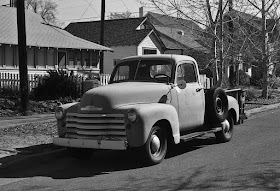New Mexico has a secure place in the history of photography. Many of photography's great practitioners were attracted to the state by the special light and the persistence of the ancient cultural ways. Ansel Adams did his best early work in Taos under the tutelage of Paul Strand. Russell Lee, John Collier and Jack Delano carried documentary photography to new heights in New Mexico during the Depression years with FSA and OWI sponsorship. Van Deren Coke was the UNM Art Department head and the first director of the Art Museum in the 1960s. Beaumont Newhall developed the school's graduate program in the history of photography in the 1970s. New Mexico today remains a mecca for photographers, including quite a few who persist in the practice of film photography.
The following is a list of links to New Mexico film photographers whose work I follow on line.
* * * * *
Jon Caradies (Santa Fe)
Carefully crafted b&w images of Northern NM made with Leica, Nikon and Hasselblad.
Robert Christensen (Belen)
A specialist in vernacular architecture whose work was featured in an exhibit at the Albuquerque Art Museum. A review of the Museum show and a description of Christensen's technique is available in an
article at the New Mexico Magazine site.
Vincent Frazzetta (Bernalillo)
High quality film photography work from Maine to New Mexico.
Anthony Gross aka: Fixinater (Portales)
"I buy / sell / trade / fix old film cameras"
He also makes very fine photos with a great variety of classic cameras.
(It appears he has abandoned Flickr and deleted his images there.)
Seth Jacob (Albuquerque)
Very fine writing and images on his blog.
Stephanie Lakos (Las Vegas)
Excels in capturing the essence of northern NM with Holgas, Polaroids and an assortment of classic film cameras. (I believe Stephanie has moved to Portland.)
Jorge Guadalupe Lizárraga (Albuquerque)
Under the screen name "el zopilote" Lizárraga has gained a large following on Flickr where he posts almost daily. He has a unique style with a focus on architecture and landscape with very little difference evident between the film and digital images.
Lee Palmer (Albuquerque)
Technically excellent b&w work with classic cameras and films, often expertly processed in pyro developers.
Gregory Peterson (Albuquerque)
Documenter of the University District. His fine collection of old cameras was recently on display in the UNM Fine Arts Library.
Becky Ramotowsky (Tijeras)
A multimedia artist whose photo work is often accomplished with the simplest of pinhole cameras and processed in home-brew caffenol. Besides showing her work in her blog,
Palomino Pinhole and Other Distractions, she is also an active participant in the excellent
Filmwasters forum.
Mike Tungate (Albuquerque)
A versatile photographer whose work encompasses a wide variety of subjects throughout New Mexico. In addition to showing his photos on Flickr he also maintains a blog,
mtungate, where he shows his 35mm and medium format work.
Joe Van Cleave (Albuquerque)
An innovator and experimenter with alternative photographic processes and equipment who often makes extraordinarily fine images from paper negatives.
Martin Ventura (Albuquerque)
Expert commercial photography for all occasions including events and portraiture.
* * * * *
There is a
New Mexico Film Photographers group at Flickr which was started nine years ago. The group has not had many contributions lately, but some of the best photographers in the state posted examples of their work there in the past. Perhaps with a bit of encouragement they could be lured back along with some who are newly arrived to the pleasures and challenges of film photography.
UPDATE:
I've accepted responsibility for administering the New Mexico Film Photographers group on Flickr. I'll be sending out invitations to post photos there. I would particularly like to find some more participants from the southern half of the state.
.jpg)







































